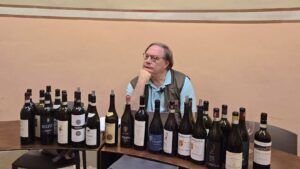In the landscape of Italian wine, certain names transcend regional borders, stylistic categories, and even national identity to become enduring emblems of global wine culture. Tenuta San Guido is one such name. While the world may know its flagship wine Sassicaia, it is the estate’s name—Tenuta San Guido—that deserves special recognition. Not only does it lend its name to Italy’s only single-estate denominazione (Bolgheri Sassicaia DOC), but it also represents a fusion of viticulture, environmental conservation, and elite thoroughbred breeding.

Tenuta San Guido: Estate and Terroir
Tenuta San Guido is located on the western coast of Tuscany, in the Bolgheri area, between the towns of Livorno and Grosseto. The estate stretches inland from the shores of the Tyrrhenian Sea to the hilly hinterlands, covering more than fifteen kilometers in length and encompassing a range of altitudes from 80 to 400 meters above sea level. This diverse geography provides ideal conditions for viticulture, particularly for Bordeaux varieties such as Cabernet Sauvignon and Cabernet Franc.
The entire estate covers approximately 2,500 hectares, of which around 100 hectares are planted with vines. The vineyards are rooted in soils composed primarily of limestone, clay, and gravel—offering excellent drainage and mineral richness, both of which contribute to producing wines with firm structure and complex flavor profiles. In addition to vineyards, the estate is home to a 580-hectare nature reserve, managed by the World Wildlife Fund for Nature (WWF) since 1959. As Italy’s first private nature reserve, it serves as a haven for migratory birds and diverse wildlife, underscoring the estate’s long-standing commitment to environmental conservation. The property also includes the renowned Dormello-Olgiata thoroughbred breeding stable, known for its historical significance and the production of numerous champion racehorses—another testament to the estate’s prestige beyond wine. I visited both extensively during a one week-stay in the region and I can say they say as much about San Guido’s greatness as its wines do. Indeed, there is alogic to greatness and you can tell in all the attention to the small details, the quest for excellence and the visionary reality this estate is all about.

The estate’s location and topographical diversity give rise to a unique mesoclimate: proximity to the Tyrrhenian Sea moderates the summer heat with cooling sea breezes and nighttime temperatures, helping the grapes preserve acidity and aromatic expression. The soils, rich in limestone, clay, and gravel, further impart mineral character and aging potential to the wines. Different exposures and topographical changes lead to different microclimates as well. Together, these natural conditions define the distinctive terroir of Tenuta San Guido, resulting in wines of elegance, complexity, and longevity.
Three Wines, Three Paths: Not a Hierarchy but an Identity
Tenuta San Guido produces three red wines—Le Difese, Guidalberto, and Sassicaia; the first two are labeled as Toscana Rosso wines, while Sassicaia, as mentioned, has its own single wine DOC. But, and this is very important, unlike the Bordeaux model of grand vin and second vin labels, these wines are not defined by a quality ladder, but by distinct vineyard origins, varietal compositions, winemaking philosophies, and stylistic intentions. In other words, they are three completely different wines: one is not the second or the third of another.
• Sassicaia
Made mostly from the estate’s highest and oldest vineyards (up to 400 meters altitude), particularly the gravelly slopes of Castiglioncello and Mandrioli. A blend of Cabernet Sauvignon and Cabernet Franc, it differs from almost all other Bordeaux blends in the area also because it never had any Merlot in it. (Interestingly, most Bolgheri estates who started out with Merlot in the blend have since shied away from it.) Sassicaia is structured, restrained, and elegant with outstanding aging potential, which mean it doesn’t always come out flashy and impressive in blind tastings of young wines: but experienced palates have no trouble picking up oin its elegance and refinement. Sassicaia was first released commercially in 1968 and awarded its own DOC in 1994.
• Guidalberto
Introduced in 2000. A blend of Cabernet Sauvignon and Merlot, sourced from hillside vineyards at 100–300 meters altitude. Full-fruited and structured, matured 12–16 months in oak, including 5–7% American oak barrels. A modern, robust expression of Bolgheri that is a completely different wine from Sassicaia, and not its second wine as is often mistakenly thought. Not only is it made with Merlot, which Sassicaia has never had in its blend, but is also made from different vineyards. Guidalberto ranks amongst Italy’s most underrated red wines.
• Le Difese
Launched in 2002, this is a blend of Cabernet Sauvignon and Sangiovese, with the latter mainly from inland Tuscany (Chianti Rufina and Chianti Montespertoli). Aged 6–8 months in used barrels, it is a bright, direct, and ideal wine for everyday enjoyment, providing wine lovers with a glimpse of the San Guido work ethic and wine style.
The recent vintages in Bolgheri represented in this tasting report
The wines tasted in this session of the Prestige Masterclasses Program of the VINO100/Ian D’Agata Selected Italian Wines 2025 show held in Shanghai span several key vintages from the past decade. Below is a summary of the climate conditions and stylistic characteristics of each year in the Bolgheri region—essential to understanding how each vintage shaped the wines’ personalities. That much said, keep in mind that although Bolgheri lies within Tuscany, its climate differs markedly from that of Chianti Classico or Montalcino. Strong vintages in the interior may not perform equally well on the coast—and vice versa. For instance, while 2010 was outstanding in Montalcino, it was less favorable in Bolgheri. Importantly, when reviewing vintage charts or just listening to someone prattling on about what the year’s growing season weather was like, remember that Sassicaia consistently overperforms in difficult years, much like Château Latour in Bordeaux. Even in lesser-regarded vintages such as 1984, 1992, and 2014, it maintains elegance, purity, and typicity—often surpassing its Tuscan and Italian peers.

2011 – Ripe and generous; early-drinking vintage
A warm spring followed by a hot but not extreme summer and a stable harvest window. Grapes ripened well with high sugar levels but lower acidity. The resulting wines are round, fruit-forward, and structurally moderate. Best enjoyed in youth or mid-term, with limited long-term aging potential. Overall, this is a much better vintage than it was in other parts of Italy, where it was just too hot and many reds, despite initial praise, are marred by gritty tannins.
2016 – Iconic and classical; built for the ages
Nearly flawless weather conditions: a wet spring, hot summer with wide diurnal swings, and dry September. Excellent phenolic ripeness and preserved acidity, with Cabernet Franc performing exceptionally well. Wines show impeccable balance, great structure, and aging potential of two decades or more.
2019 – A model of balance; layered and composed
A rainy spring delayed flowering; a warm summer and timely August rains led to a stable harvest under dry September skies. Grapes achieved harmony of ripeness and freshness. Wines are complex and introspective, with well-defined structure—an archetype of the “quietly powerful” vintage.
2021 – One of the greats; defined, focused, pure
Smooth budbreak, dry and sunny summer without excess heat. Grapes ripened ideally, retaining high natural acidity and concentration. The wines offer remarkable balance, vibrant fruit, and clear mineral structure. Many critics hailed it as one of Sassicaia’s finest vintages since 1985. In general, just about everyone in Tuscany who knew what they were doing and had great terroirs to work with, and especially so on the Tuscan Coast, made some of their estate’s greatest wines of all time, or very close to it.
2022 – Dry and demanding; a winemaker’s vintage
A difficult growing season marked by prolonged drought and extreme summer heat, especially in July and August. Yields were low. Success depended on timely harvests and precise cellar management. Top estates preserved clarity of fruit and refreshing acidity, producing tight, savory wines that are far better than expected.
2023 – Fruit-forward and friendly; polished and generous
A rainy spring set the stage for a hot but stable summer, with a dry and favorable harvest window. Grapes reached full sugar ripeness, and wines show attractive fruit purity, medium structure, and supple tannins. Approachable early, they offer immediate pleasure while retaining regional typicity.

The wines in this tasting report



